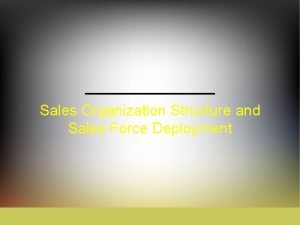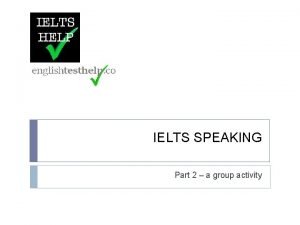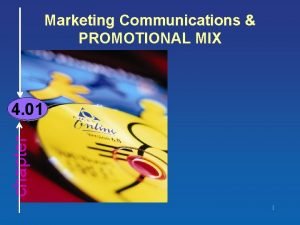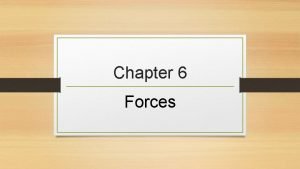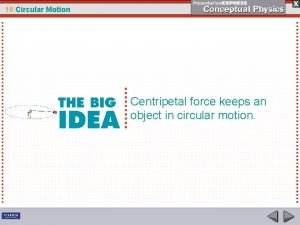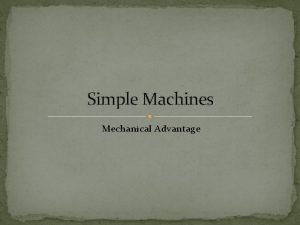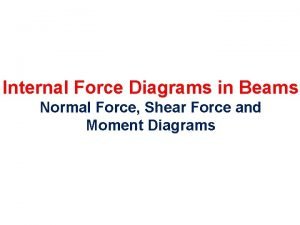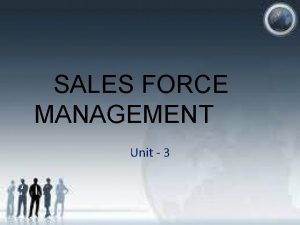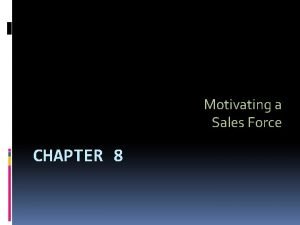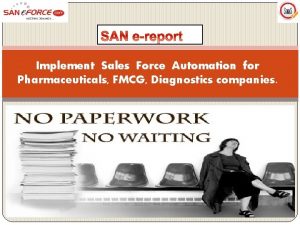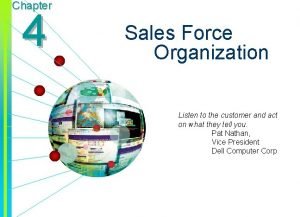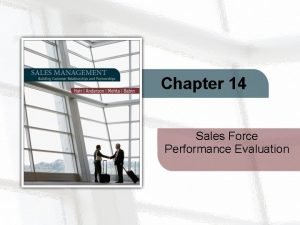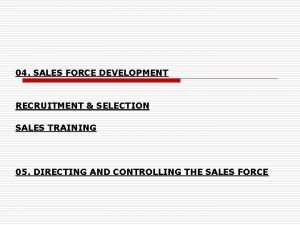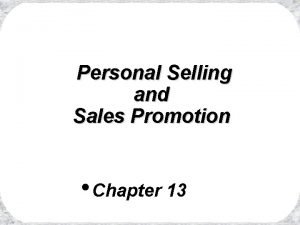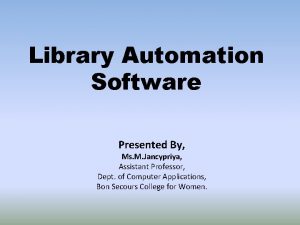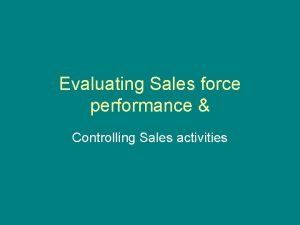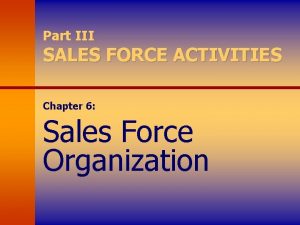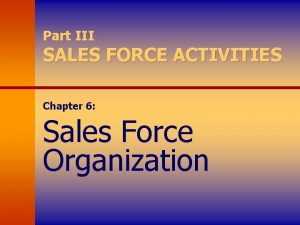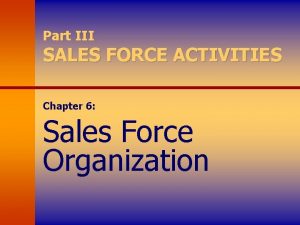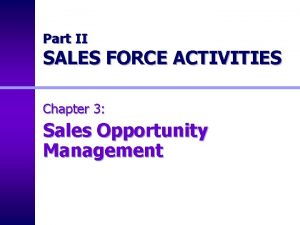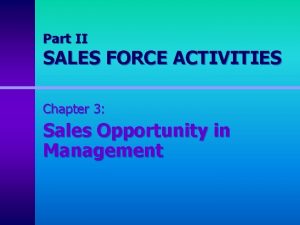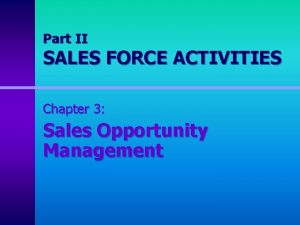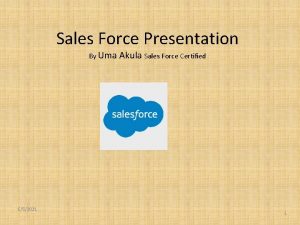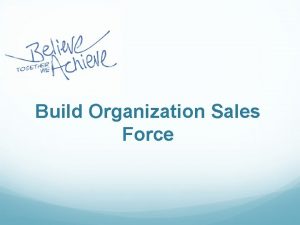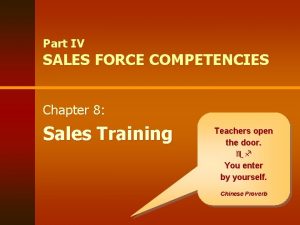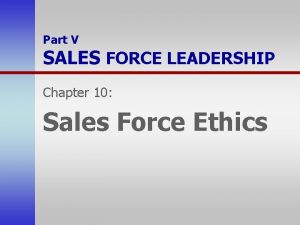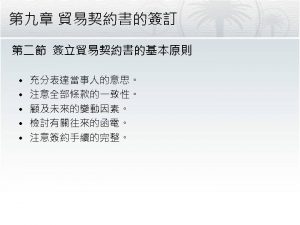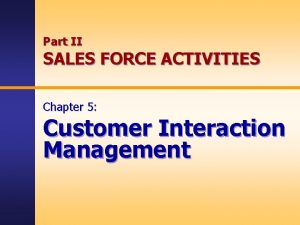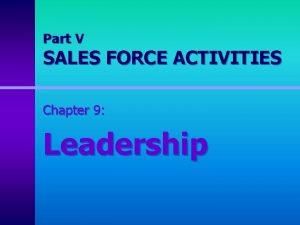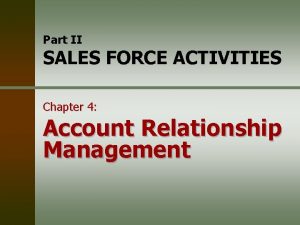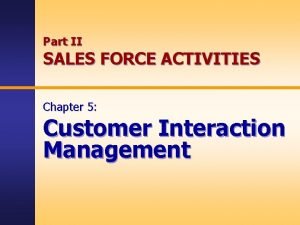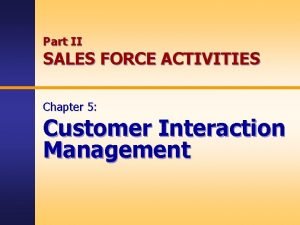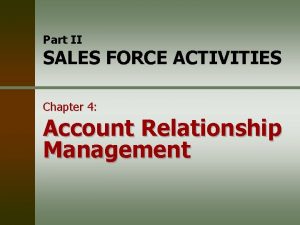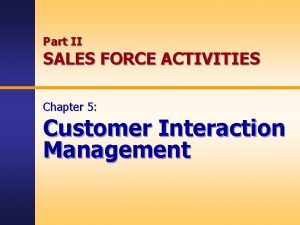Part III SALES FORCE ACTIVITIES Chapter 6 Sales







































- Slides: 39

Part III SALES FORCE ACTIVITIES Chapter 6: Sales Force Organization

XEROX Reorganization Story

Learning Objectives: § Explain the various ways to organize sales force. § Explain what a strategic accounts management program means. § State the reasons for the growth in telemarketing. § Tell why and when sales agents are utilized. § Describe evolving trends in sales force organization.

Chapter Outline: § Sales Force Organization. § Strategic Account Management Program. § Telemarketing. § Independent Sales Agents. § Emerging Sales Force Organization.

Sales Force Organization: Impact Structure Sales Management Role Compensation Recruiting/ Selection Training Program Performance Evaluation Figure 6 -1: Decisions Affected by Sales Force Organization

Sales Force Organization: Topics Sales Force Generalists Sales Force Specializatio n Strategic Account Management Telemarketi ng Emerging Issues

Sales Force Organization: § Generalist Structure. § Product Specialization. § Customer Specialization. § Functional Specialization.

Strategic Account Programs: Survey Results 49% Today In Five Years 45% 24% 18% 20% 17% 16% 11% Customer Generalist Product Lines Figure 6 -2: How Sales Forces are Organized Functional

Sales Force Organization: Generalist (Geographic Organization)

Sales Force Organization: Generalist National Sales Manager Central Regional Sales Manager Eastern Regional Sales Manager Western Regional Sales Manager Northeast District Sales Manager Mid-Atlantic District Sales Manager Southern District Sales Manager Connecticut Rhode Island Maine Vermont New York Massachus etts New York New Jersey Pennsylvania North Carolina South Carolina Delaware District of Columbia Georgia Alabama Virginia Maryland Mississippi Florida Figure 6 -3: Geographical Sales Organization

General Structure Organization: Analysis § Advantages - Best for homogenous group of buyers. - In-depth knowledge of the local culture, economic, and competitive conditions. § Disadvantages - Less knowledge of the product. - Inability to create solutions for the customers problems. - Focus on the easy to sell customers.

Sales Force Organization: Product Specialists National Sales Manager Eastern Regional Sales Manager Northeast District Sales Manager Printer Equipment Salesperson Server Salesperson Mid-Atlantic District Sales Manager Minicomputer Salesperson Programmable Calculator Salesperson Figure 6 -4: Product Specialized Sales Force Southern District Sales Manager Copier Salesperson Large Computer Salesperson

Product Specialist Organization: Analysis § Advantages - Allows focusing of sales effort - Expertise developed in limited number of products § Disadvantages - More expensive to operate - May result in duplication of sales calls to clients

Sales Force Organization: Customer Specialists National Sales Manager National Accounts Manager Northeast District Sales Manager Salesperson For Educational Institutions Manager of Export Sales Eastern Regional Sales Manager Mid-Atlantic District Sales Manager Salesperson for Retail Customers Southern District Sales Manager Salesperson for Government Agencies Salesperson for Manufacturers Figure 6 -5: Customer Specialized Sales Force Salesperson for Bank Customers Salesperson for Wholesale Customers

Customer Specialist Organization: Analysis § Advantages - Consistent with market driven strategy - Salespeople become customer experts - Customer segments receive appropriate resources § Disadvantages - May conflict with marketing organization - Product expertise may be lacking - More expensive

Sales Force Organization: Functional Specialists Division Marketing Manager Industry Sales Manager Account Executives (Salespeople) Systems Manager Administrative Manager System Reps Market Administrative (Technical Support) Figure 6 -6: Functional Specialization (Training & Installation)

Functional Specialists: Alternatives Companies New Customers § American Express § Gillette Retention § Browning-Ferris Industries End-Users § Lexmark International Sales Engineers § § Service Consultants § § 3 M AT&T IBM Mc. Kesson Corporation

Functional Specialists: Analysis § Advantages - More functional focused. - Ability to provide problem solutions. § Disadvantages - May conflict with marketing organization - More expensive

Strategic Account Management Program § What is a SAMP? § How to select strategic accounts? § How to organize sales people?

Strategic Accounts: Who are Strategic Accounts? § When a customer purchases a significant volume and exhibits one or a combination of the following: - Multiple people are involved in the buying process - Purchasing is centralized - The customer desires a long-term, cooperative working relationship - The customer expects specialized attention and service

Strategic Accounts: Common Problems with Account Selection § Too many “strategic accounts” § “We see them as strategic, but they don’t even see us on their radar. ” § Too much organizational effort directed towards big name accounts § Not thinking enough about return on relationship investment § No common process across the organization § No tracking and reviewing of strategic account selection

Strategic Accounts: Alternative Organization Models § Existing Sales Force - Low risk; little change § Management Sell National Accounts - Keeps management close to customer § Separate Sales Force - More aggressive; more expensive; alternative to sales management for promotion for sales staff § Sales Teams - Use when selling process is complex

Strategic Accounts: Alternative Organization Model Effectiveness Existing Sales Force § Least effective § Lowest market performance Sales Management § Somewhat more effective § Slightly better market performance Separate Sales Force § Fairly effective § Good Market Performance Cross-Functional § Most effective Sales Teams § Best Market Performance Table 6 -1: Doing the Math on Account Management

Strategic Accounts Programs: Benefits Increased sale to national accounts 91% Increased profits from national accounts 83% Increased market share 74% Improved customer communications 74% Improved customer coordination 30%

Strategic Accounts Programs: Insights from Strategic Account Executives “Until the customer tell us we’re a strategic supplier, I can’t believe that they are in fact a strategic account for us. ” “Strategic accounts bring the opportunities to you, instead of you always having to try to push the ideas on them. ” “If our products and services aren’t critical to our customer’s performance and results, it is silly to call them ‘strategic accounts’. ”

Strategic Account Programs: Survey Results How do you measure the success of a strategic account program? Sales Volume 80% Customer Satisfaction 53% Profitability 45% Volume of Recurring Revenue Stream 29% Incremental Orders from Existing Accounts 22% Number of Customer with Strategic Account Agreements 11% Number of Transactions/Orders 6% Number of Products Shipped 6%

TELEMARKETING § What is Telemarketing? § What are the advantages and challenges of telemarketing?

Sales Force Organization: Telemarketing Advantages and Challenges Advantages § Low cost per sales call § Profitably serve small to medium customers § Speed/time saving of telephone ordering Challenges § Acceptance by field salespeople § Management § Role of the Internet

Sales Force Organization: Scope of Telemarketing Activity Description Customer Service § Companies provide customers with a number they can call if they have questions. Prospecting and Lead Qualification § Firms are taking a proactive approach to prospecting by having telemarketers call prospects or qualify them for face-to-face selling. Account Management § Selling secondary product lines or service small customers by phone, thereby freeing their salespeople to concentrate on larger customers and strategic product lines. Promotion Support § Develop newspaper and magazine ads that feature either a local or an 800 number to get additional product information or place an order. Figure 6 -8: The Scope of Telemarketing Activities

Independent Sales Agents § What is a Sales Agent? § When to use a Sales Agent? § How to Select a Sales Agent?

Independent Sales Agents § The Sales Agent is an independent business given an exclusive contracts to perform the selling functions within a specified geographic areas. § They take neither ownership nor physical possession of the product they sell. § They always compensated by commission.

Selecting a Sales Agent Three issues to consider before selecting the sales agent: 1. Economic Consequences. 2. Level of Control. 3. Market Conditions. §

Selecting a Sales Agent Economic Consequences: Independent Agents Total Selling Costs Own Sales Force Break-Even Sales Volume Figure 6 -9: Total Costs of Independent Agents vs. Own Sales Force

Selecting a Sales Agent Level of Control: § Control of Sales Force VS. Control of Sales Agent.

Selecting a Sales Agent Market Conditions Favoring Sales Agents § The market is fragmented and customers are difficult to find or understand. § The products are easily understood commodities that have been around for a long time. § Buying is decentralized. § Local knowledge and local distribution is important. § The selling cycle is short and orders are typically small. § The company is selling only a few products. § It is not necessary to tightly control the selling effort. § There is a good potential sales agency who has significant marketing expertise in the industry. § Ongoing support activities are not important and the company does not need customer information. § The company is not well known and has little equity in the market. Figure 6 -10: Market Factors Favoring the Use of Sales Agents

Selecting A Sales Agents Selecting a Sales Agency 1. Define the ideal market focus. 2. Identify compatible principles. 3. Specify the necessary technical background. LOCATING AGENTS: Rep. Directories Customer References Compatible Manufactures References from Current Agents Trade Shows

Emerging Sales Force Organization Issues § Centralization Versus Decentralization. § Cross- Functional Coordination. § Global Account Organization. § Sales Teams. § Selling Partners.

Global Account Success Keys 1. The company’s value proposition must be right. 2. Global account teams must be crossfunctional 3. Account teams must be driven from the top. 4. A mindset of constant improvement is key.

Sales Force Organization: Evaluating Organizational Structure § Financial performance -- must consider BOTH costs and revenues § Adaptability External Internal - New competitors - Changing technology - Modification to channel systems - Industry life cycle - Company goals Management philosophy Production capabilities Technical resources § Integration -- subunits of sales organization must work in harmony
 Product sales force structure
Product sales force structure Metode sales force structure
Metode sales force structure Hamlet act iii scene ii
Hamlet act iii scene ii Va handbook 5017 employee recognition and awards
Va handbook 5017 employee recognition and awards The statement of cash flows helps users
The statement of cash flows helps users Group these activities into indoor and outdoor activities
Group these activities into indoor and outdoor activities Support activities and primary activities
Support activities and primary activities Definition of primary activities
Definition of primary activities Ielts speaking group
Ielts speaking group 4 promotional mix
4 promotional mix Contact vs noncontact forces
Contact vs noncontact forces Which arrow below represents the direction of acceleration
Which arrow below represents the direction of acceleration Contact vs long range force
Contact vs long range force What force provides centripetal force
What force provides centripetal force The ratio of resistance force to effort force
The ratio of resistance force to effort force Unbalanced force
Unbalanced force What is a centrifugal force in geography
What is a centrifugal force in geography Is air resistance a non contact force
Is air resistance a non contact force Why electric field is conservative
Why electric field is conservative Centripetal force and gravitational force
Centripetal force and gravitational force Normal force and gravitational force
Normal force and gravitational force Shear force diagram
Shear force diagram Addition symbol
Addition symbol Part to part ratio definition
Part to part ratio definition Part part whole
Part part whole Define technical description
Define technical description Front bar layout
Front bar layout The part of a shadow surrounding the darkest part
The part of a shadow surrounding the darkest part Part to part variation
Part to part variation Sales force management definition
Sales force management definition Apa itu sales force automation
Apa itu sales force automation Motivating sales force
Motivating sales force Fourrts e reporting
Fourrts e reporting Functional sales organization adalah
Functional sales organization adalah Sales evaluation process
Sales evaluation process Objectives of sales quota
Objectives of sales quota Methods of recruitment and selection of salesperson
Methods of recruitment and selection of salesperson Sales promotion
Sales promotion Winisis library software
Winisis library software Controlling the sales force is an activity of
Controlling the sales force is an activity of

